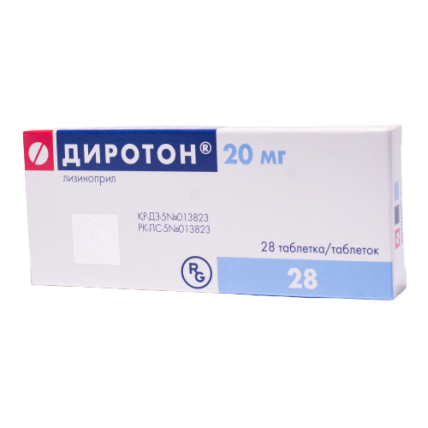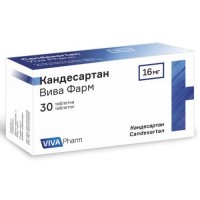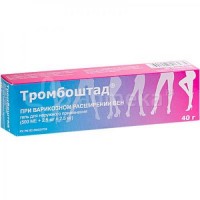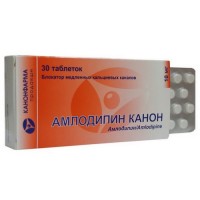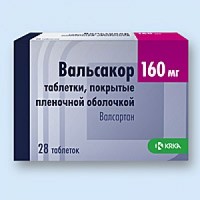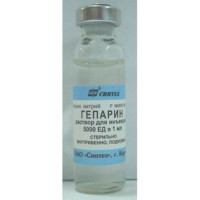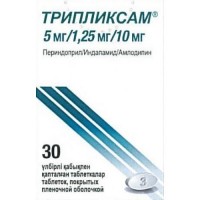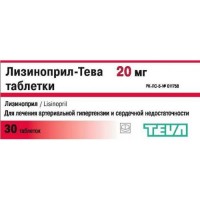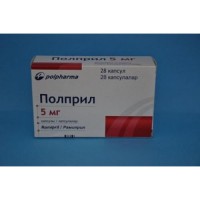Diroton (Lisinopril) 20 mg, 28 tablets
- $19.80
The instruction for medical use
of DIROTON® medicine
the Trade name
of Diroton®
the International unlicensed
name Lisinopril Dosage Form
of the Tablet of 2.5 mg, 5 mg, 10 mg and 20 mg
Structure
One tablet contains
active agent - lisinopril of 2.5 mg, 5 mg, 10 mg, 20 mg (in the form of 2.72 mg, 5.44 mg, 10.89 mg, 21.77 mg of lisinopril of a dihydrate),
excipients: magnesium stearate, talc, Mannitolum, starch corn, hydrophosphate calcium dihydrate.
The description
of the Tablet of round shape, with a flat surface, white or almost white color, with a facet, with an engraving 2.5 on one party and risky on another (for a dosage of 2.5 mg).
Tablets of round shape, with a flat surface, white or almost white color, with a facet, with an engraving 5 on one party and risky on another (for a dosage of 5 mg).
Squared tablets, with a biconvex surface, white or almost white color, with an engraving 10 on one party and risky on another (for a dosage of 10 mg).
Tablets of a pentagonal form, with a biconvex surface, white or almost white color, with an engraving 20 on one party and risky on another (for a dosage of 20 mg)
Pharmacotherapeutic group
the Enzyme Angiotensin-converting (EAC) inhibitors. Lisinopril
the ATX C 09A A03 Code
the Pharmacological
Pharmacokinetics Absorption Meal properties does not influence lisinopril absorption. At oral administration of lisinopril the peak of concentration in serum is reached approximately in 7 hours. Average speed of absorption of lisinopril is about 25% at reception of a dose of 5-80 mg. The variability of indicators between patients can be from 6 to 60%. The absolute bioavailability of lisinopril decreases approximately up to 16% at patients with NYHA of class II-IV of heart failure.
Distribution
Krom of linking with APF, lisinopril does not contact other serum proteins. Lisinopril in small degree gets through a blood-brain barrier.
Removal
Lisinopril is not exposed to metabolism and is removed only through kidneys in an invariable look. After increase in a dose the effective half-life period is 12.6 hours. The clearance of lisinopril is about 50 ml/min. After removal of a significant amount of free active agent slower removal of the fraction connected with APF follows.
The abnormal liver function
At the patients having cirrhosis, absorption of lisinopril slows down depending on an abnormal liver function approximately for 30% (as it is defined at discharge with urine). On the other hand, its removal decreases and leads to increase in efficiency of lisinopril by 50%.
The renal failure
the Renal failure reduces removal of lisinopril which is removed through kidneys. This reduction has clinical value only if the level of glomerular filtration is less than 30 ml/min. If the clearance of creatinine is 30-80 ml/min., average area under a curve increases only by 13%. If the clearance of creatinine is from 5 to 30 ml/min., despite this, average area under a curve increases by 4.5 times in comparison with norm. Lisinopril can be removed by means of dialysis.
Heart failure
in the presence of heart failure influence of lisinopril increases in comparison with healthy patients (AUC increases approximately by 25%). On the other hand, the absolute bioavailability of lisinopril decreases approximately to 16% at patients with heart failure.
Elderly patients
At elderly patients the level of lisinopril are usually higher for a cause of infringement of function of kidneys, AUC is about 60% higher, than at younger patients.
The pharmacodynamics
of Diroton® belongs to group of inhibitors the angiotensin-the turning enzyme (ATE), reduces the level of angiotensin-II and Aldosteronum in plasma, at the same time increasing concentration of a vazodilatator of bradykinin. Causes decrease in peripheral resilience of vessels and arterial blood pressure, the minute volume of heart can increase at invariable heart rate. Lisinopril is capable to improve blood circulation in kidneys.
At patients with a hyperglycemia contributes to normalization of function of the injured glomerular endothelium.
Hypotensive influence of lisinopril is shown, as a rule, within 1 hour after reception and reaches peak in 6 hours. Duration of action depends on a dose and is 24 hours. The hypotensive effect at prolonged use of drug decreases. At sharp drug withdrawal, big differences of arterial blood pressure are not observed (withdrawal).
In spite of the fact that its main effect is mediated renin-angiotensin-aldosteronovoy by a system, the efficiency was confirmed at the patients having hypertensia with the low content of renin in plasma.
Besides direct lowering of blood pressure of Diroton® reduces an albuminuria due to changes of histology and a hemodynamics of the glomerular device of kidneys. At patients with diabetes fluctuations of level of sugar of blood, increase of a hypoglycemia were not observed.
Indications
- hypertensia (as monotherapy or in a combination with other antihypertensive drugs)
- symptomatic arterial hypertension, including in
the diabetes 2 types complicated by hypertensia and an initial nephropathy
- heart failure (as a part of combination therapy)
- an acute myocardial infarction with a stable hemodynamics in the first 24 hours
for prevention of dysfunction of a left ventricle and development of heart
failure and also for the purpose of increase in survival (as a part of
combination therapy)
to accept the Route of administration and doses Irrespective of indications once a day, at the same time day, irrespective of meal since food does not affect absorbability.
Essential hypertensia
the Recommended initial dose for the patients who are not accepting other antihypertensives, 10 mg a day. The usual maintenance dose makes 20 mg/days, depending on pressure it is possible to increase a dose to 40 mg/days. If the therapeutic effect is insufficient, it is necessary to complement therapy with other antihypertensive drug.
At increase in a dose it is necessary to consider that full manifestation of hypotensive effect requires 2-4 weeks.
In case of the patients accepting diuretic means in 2-3 days prior to therapy of Dirotonom® the intake of diuretic drugs should be stopped. In cases when it is impossible, the initial dose of Dirotona®
should not exceed 5 mg/days, at the same time it is recommended to provide medical observation of the patient after reception of the first dose since development of symptomatic hypotonia is possible (the maximum action is shown in 6 h after administration of drug).
The renovascular hypertensia and other states connected with superactivity system renin-angiotensin-aldosteronovoy. The recommended initial dose makes 2.5-5 mg/days at stringent control of arterial blood pressure, function of kidneys, potassium level in serum. The maintenance dose has to be titrated – without interruption of stringent control – according to observed reaction of arterial blood pressure.
Features of use in a renal failure
As elimination of lisinopril is carried out through kidneys, the initial dose depends on indicators of clearance of creatinine, the maintenance dose depends on clinical reaction and is selected at regular measurement of indicators of function of kidneys, potassium concentration and sodium in blood.
The clearance of creatinine
(ml/min.)
the Initial dose
(mg/day)
31-80 10-30
& lt, 10
(including the patients who are on a hemodialysis) *
5-10 2,5-5
2.5#
* intake of lisinopril can be stopped for the period of carrying out a hemodialysis.
# the Dose and frequency of intake of medicine is determined by parameters of a lowering of arterial pressure.
The maximum dose of lisinopril makes 40 mg/days.
Heart failure
of Diroton® it is possible to apply along with diuretics and/or a digitalis. At the same time previously, as far as possible, the dose of diuretic should be lowered. The initial dose makes 2.5 mg, it can be gradually increased to a usual maintenance dose of 5-20 mg/days.
The recommended coefficient of increase in a dose in 2 weeks makes no more than 10 mg. The maximum daily dose of Dirotona® makes 35 mg/days.
Prior to the beginning of and during a course of treatment the regular control of arterial blood pressure, function of kidneys, level of potassium and sodium in serum as the hypotension accompanied with a renal failure can develop is necessary.
The diabetic nephropathy
In diabetes 2 types, complicated by hypertensia and an initial stage of a nephropathy, a daily dose makes 10 mg of Dirotona® once a day. If necessary the dose can be increased up to 20 mg/days to reduce diastolic arterial blood pressure lower than 90 mm Hg. An acute myocardial infarction
in case of use of Dirotona® in the first 24 hours after a heart attack, the initial dose of drug makes 5 mg, in 24 hours repeatedly appoint 5 mg, in 48 hours - 10 mg, further the maintenance dose makes 10 mg. Duration of a course of treatment is 6 weeks. In case of need treatment is carried out according to the usual scheme in such cases, e.g., appoint trombolitik, acetylsalicylic acid and β-blockers.
With a low systolic pressure (≤ 120 mm Hg) treatment is begun with a low dose (2.5 mg/days). In case of development of hypotension when systolic pressure ≤ 100 mm Hg, reduce a maintenance dose to
5 mg/day, in case of need it is temporarily possible to appoint 2.5 mg/days.
In steady hypotension (systolic pressure & lt, 90 mm Hg within more than one hour), drug it is necessary to suspend reception.
Use for elderly patients
In clinical trials is not revealed differences in efficiency or safety of treatment by lisinopril depending on age. As at advanced age the depression of function of kidneys is often observed, it is necessary to define the dose accepted in a renal failure.
Use for patients with a kidney transplant
Experience of use of lisinopril for patients directly after renal transplantation is absent, therefore, treatment of Dirotonom® is not recommended to such patients.
Side effects
Side effects carry, usually, easy and passing temper and only in rare instances demand the treatment termination.
Often (≥1/100 до<, 1/10)
- dizziness, a headache, orthostatic hypotonia, weakness
- dry cough
- nausea, vomiting, diarrhea
- skin rash
- a stethalgia
- a renal failure
Infrequently (≥1/1000 до<, 1/100)
- paresthesia, vertigo, taste disorder, change of mood, a sleep disorder, disturbance of cerebral circulation
- fatigue, an asthenia
- tachycardia, a myocardial infarction
- dyspepsia, pains in a stomach
- hypersensitivity reactions with edema of face, extremities, lips,
language, the sky and a throat, an erythema, an itching
- inflammation of a mucous membrane of a nose
- a Raynaud's disease
- impotence
- a hyperpotassemia, an azotemia, increase in level of creatinine, increase in level of urea in blood and activity of transaminases of a liver
is rare (≥1/10000 до<, 1/1000)
- the confused consciousness
- dryness in a mouth
- urticaria, an alopecia, psoriasis
- a gynecomastia
- increase in a hematocrit, decrease in level of hemoglobin, increase in level of serumal bilirubin, a hyponatremia
- uraemia, a renal failure
Very seldom (& lt, 1/10000)
- an autoimmune disease
- a hypoglycemia
- a bronchospasm, sinusitis, an allergic alveolitis, eosinophilic pneumonia
- pancreatitis, hepatocellular or cholestatic jaundice, hepatitis, a liver failure
- an intestinal Quincke's disease
- the increased sweating, a bladderwort, a toxic epidermal necrolysis, Stephens-Johnson's syndrome, a polymorphic erythema, a skin pseudo-lymphoma
- an oliguria/anury
- suppression of activity of marrow, anemia, thrombocytopenia, a leukopenia, a neutropenia, an agranulocytosis, hemolytic anemia, a lymphadenopathy
Frequency is unknown
- a faint
- a depression
Skin reactions can be followed by heat, muscle pains, an arthralgia, a vasculitis, an eosinophilia, a leukocytosis and/or positive reaction to antinuclear antibodies. At development of heavy skin reaction it is necessary to interrupt treatment with lisinopril and to see immediately the attending physician.
Contraindications
- hypersensitivity to any component of drug
- allergic swelled in the anamnesis, caused by any APF inhibitor
- a hereditary or idiopathic angiodema
- primary hyper aldosteronism
- a stenosis of the mouth of an aorta, considerable in terms of a hemodynamics, or
the mitral valve
- a hypertrophic cardiomyopathy
- pregnancy, the lactation period
- cardiogenic shock
- hemodynamically unstable state after an acute
myocardial infarction
- patients with an acute myocardial infarction and decrease in renal function
(clearance of creatinine & gt, 177 µmol/l and/or the proteinuria & gt, 500 mg / 24 hour)
- a bilateral renal artery stenosis or a renal artery stenosis
of the only kidney
- a state after transplantation of kidneys
- the progressing azotemia, a hyperpotassemia
- children's age up to 18 years
Medicinal interactions
requires Special attention simultaneous use of Dirotona® with the following drugs:
kaliysberegayushchy diuretics (Spironolactonum, Triamterenum, amiloride), potassium and kaliysoderzhashchy deputies of salts. In such cases the development of a hyperpotassemia, mainly, in a renal failure is possible therefore simultaneous use of these drugs is possible only after assessment of probable consequences and at regular control both potassium level in serum, and function of kidneys.
With care it is possible to appoint together with: diuretics. The concomitant use of diuretics with lisinopril, as a rule, makes hypotensive impact. It is necessary to show extra care at addition of Dirotona® to therapy of the patients accepting diuretics as the considerable lowering of arterial pressure can occur owing to reduction of volume of intercellular liquid and/or excess removal of sodium chloride from an organism. Risk of developing symptomatic hypotension can be reduced at the termination of intake of diuretics and increase in volume of liquid or consumption of salt, prior to definition of a dosage of lisinopril and also in an initiation of treatment by low doses of APF inhibitors.
Other antihypertensive drugs
Intake of other accompanying antihypertensive drugs can enhance antihypertensive effect of Dirotona®.
The concomitant use of nitroglycerine and other nitrates or other vasodilators can reduce arterial blood pressure in addition.
Non-steroidal anti-inflammatory drugs (including acetylsalicylic acid in a dosage of 3 g/days)
Non-steroidal anti-inflammatory drugs (NPVP) can reduce hypotensive effect of APF inhibitors. Also it is reported about the increase in level of potassium in serum caused by NPVP and APF inhibitors that can cause a renal failure. This influence, as a rule, is reversible, and its manifestation is possible, first of all, at patients with the previous renal failure.
Acetylsalicylic acid, thrombolytic drugs, beta-blockers, nitrates
Lisinopril can be applied along with acetylsalicylic acid (in cardiological doses), thrombolytic drugs, beta-blockers and/or nitrates under observation.
Lithium drugs
APF Inhibitors can reduce lithium excretion that can be followed by increase in toxicity. In view of this fact, the concomitant use of Diroton with lithium drugs, however is not recommended if the concomitant use of these drugs is necessary, it is regularly necessary to control lithium level in serum.
Antidiabetic means
the Concomitant use of antidiabetic means with APF inhibitors can enhance hypoglycemic effect of insulin and sulphonylurea that increases risk of development of a symptomatic hypoglycemia. Nevertheless, increase in tolerance to glucose can reduce a necessary dose of insulin or sulphonylurea. This interaction, as a rule, is shown in the first week of the combined treatment at patients with a renal failure.
Sympathomimetics
Sympathomimetics can reduce hypotensive effect of APF inhibitors. For this reason it is necessary to control more carefully arterial blood pressure of the patient to establish whether the desirable therapeutic effect was reached.
Tricyclic antidepressants / neuroleptics / anesthetics
the Concomitant use of tricyclic antidepressants, neuroleptics or anesthetics can enhance hypotensive effect of Dirotona®.
Gold
Nitritoidny reactions (vazodilatation symptoms, including hyperaemia, nausea, dizziness and hypotension which can be shown in a severe form) owing to gold injections (for example, sodium aurotiomalat) it is observed more often at patients who at the same time accept lisinopril.
The special
instructions Lowering of arterial pressure accompanied with symptomatic hypotension can arise at the patients with a hypovolemia and/or reduction of volume of intercellular liquid arising in the result of treatment with diuretics, restrictions of consumption of edible salt and other forms of loss of liquid (the increased sweating, long vomiting, diarrhea, dialysis) and also in case of heart failure. When developing hypotension it is necessary to give to the patient horizontal position, as obligatory measures the intravenous injection of liquid (injection of normal saline solution) is recommended. Passing hypotension, as a rule, is not a contraindication for further treatment, nevertheless, there can be a need for the temporary termination or a dose decline.
Whenever possible, it is necessary to eliminate a hypovolemia and/or reduction of volume of intercellular liquid prior to treatment with lisinopril and to carefully check impact of an initial dose on arterial blood pressure. In case of disturbance of cerebral circulation or coronary heart disease the sharp initial falling of arterial blood pressure can be the cause of a stroke or myocardial infarction.
In case of development of an acute myocardial infarction, it is forbidden to apply lisinopril if treatment by vasodilating drugs can worsen the hemodynamic status of the patient (for example if systolic arterial blood pressure makes 100 mm Hg. or below) or in case of cardiogenic shock. If systolic arterial blood pressure of 120 mm Hg. or below, low doses (2.5 mg/days) should be applied within the first 3 days after a heart attack. In hypotension the maintenance doses should be lowered to 5 mg or about 2.5 mg are temporary. In steady hypotension (systolic arterial blood pressure is lower than 90 mm Hg. within more than 1 hour), it is necessary to suspend treatment by this drug.
Aortal stenosis / hypertrophic cardiomyopathy: as all vasodilators, APF inhibitors should be applied with care in a type of the previous obstruction of outflow tracts.
Renal failure: In case of a renal artery stenosis (in particular, in case of a bilateral stenosis or a stenosis of an artery of the only kidney), as well as at a hypovolemia and/or reduction of volume of intercellular liquid, or insufficient blood circulation, the hypotension which developed at intake of lisinopril can cause or aggravate a renal failure that can also lead to development of an acute renal failure – the last disorder, as a rule, is reversible later at therapy interruption. Slight or short-term increase of AMK and level of creatinine can also happen in the case which is not connected with vascular diseases of kidneys, in particular during a concomitant use of diuretics. It is necessary to show extra care and to carry out constant observation of function of kidneys at patients with heavy renal failures (clearance of creatinine & lt, 30 ml/minute).
It is not necessary to begin treatment in case of development of an acute myocardial infarction if function of kidneys of the patient is in a risk zone that is observed if creatinine level in serum is higher than 177 µmol/l and/or an albuminuria higher than 500 mg / 24 of hour. In case of the renal failure which developed during treatment (creatinine level in serum is higher than 265 µmol/l or is twice higher in comparison with initial level), the attending physician has to consider the possibility of interruption of treatment.
Hypersensitivity, Quincke's disease: it is in rare instances reported about a Quincke's disease of the face, extremities, lips, language, a throat and/or throat at the patients undergoing treatment by APF inhibitors including lisinopril. Swelled can develop during treatment at 0.1-1.0% of patients. In this case it is necessary to interrupt immediately treatment, the patient has to be under medical observation before total disappearance of symptoms.
Even at total fast disappearance of hypostasis from a face and lips, for relief of symptoms it is possible to use antihistamines.
The Quincke's disease affecting a throat can lead to a lethal outcome. Defeat of language, a glottis or windpipe can cause obstruction of airways therefore it is necessary to begin the corresponding treatment immediately: 0.3-0.5 ml of solution of epinephrine of 0.1% (0.3-0.5 mg of epinephrine) subcutaneously or 0.1 ml slowly intravenously, use of lyukokortikoid, antihistamines.
Surgery / anesthesia: During band operation or the general anesthesia using the drugs provoking development of hypotension, lisinopril blocks formation of angiotensin II against the background of compensatory discharge of renin. The hypotension developing as a result of operation of this mechanism can be eliminated by means of completion of volume of liquids.
Hemodialysis: It is reported about anaphylactoid reactions at the patients who are undergoing dialysis with use of polyacrylonitrile membranes from high intensity of a stream (for example, AN 69) and at the same time accepting APF inhibitor. It is necessary to avoid this combination and also to pay attention to use of other type of a dialysis membrane or other class of antihypertensive drugs.
Aferez LNP: the anaphylactoid reactions posing a threat for life (such as deep hypotension, breath disorder, vomiting, allergic skin reactions) can develop at the patients undergoing treatment by APF inhibitors during LLD (lipoproteins of low density) of an aferez using dextran sulfate. For this reason during an aferez of LNP, the APF inhibitors accepted for treatment of hypertensia or heart failure should be replaced with other drugs temporarily.
The desensitization caused by poison of insects belongs to anaphylactoid reactions at some patients accepting APF inhibitors. The data creating threat for life of reactions can be avoided by means of preliminary refusal of use of APF inhibitors.
A neutropenia / agranulocytosis
the Neutropenia / agranulocytosis, thrombocytopenia and anemia can develop during treatment by APF inhibitors of the patients having hypertensia. These pathologies were in rare instances observed at patients with normal function of kidneys and in the absence of other complications. The neutropenia and an agranulocytosis disappeared after the treatment termination by APF inhibitors.
Диротон® it is necessary to use with extra care at patients with a renal failure, in particular in the diseases affecting the vascular system of both kidneys and connective tissues (for example, a system lupus erythematosus or a scleroderma) and also during the accompanying immunosuppressive therapy (for example, corticosteroids, cytotoxic means, antimetabolites). APF inhibitors at such patients can be followed by development of especially acute infections which in certain cases do not react to intensive treatment by antibiotics.
At such patients it is necessary to check periodically the level of leukocytes in blood during treatment of Dirotonom® and also it is necessary to warn the patient about need to report about developing of any infections.
Ethnic features (race)
Inhibitors of angiotensin-converting enzyme are the reason of development of a Quincke's disease more often at black patients, than at white-skinned.
A liver failure
Seldom or never APF inhibitors can accelerate development of cholestatic jaundice or hepatitis that can lead to fast development of necrosis and sometimes death. The prime cause of this process is not known. If at the patients accepting Diroton® the jaundice or the significant increase in activity of liver enzymes develops, it is necessary to interrupt use of lisinopril and to continue treatment by alternative drugs.
At advanced age the identical doses of drug can be followed by increase in its concentration in blood, it is necessary to determine a dose with extra care by this reason and taking into account a condition of function of kidneys of the patient. Despite this, between young and elderly patients essential differences in hypotensive efficiency of lisinopril were not revealed.
Cough
Is reported about developing of cough during treatment by APF inhibitors. Cough, as a rule, dry, without phlegm, also stopped after the treatment termination.
Diabetes
Is necessary more careful control of level of glucose in the first month of treatment by APF inhibitors in addition to the previous treatment by insulin or oral hypoglycemic drugs.
Features of influence of medicine on ability to run the vehicle or potentially dangerous mechanisms
Lisinopril can make impact on ability to drive the car and to perform potentially dangerous operations (in particular, in an initiation of treatment). Thereof, the dose and the mode of dosing have to be defined individually and should not have negative impact on ability to drive the car and to perform potentially dangerous operations.
Overdose
Symptoms: hypotension, circulator shock, disturbance of electrolytic balance, renal failure, hyperventilation, tachycardia, cardiopalmus, bradycardia, dizziness, concern and cough.
Treatment: symptomatic therapy, gastric lavage, intake of adsorbents and potassium sulfate within 30 minutes after intake of lisinopril, control of vital indicators and their adjustment in intensive care unit, continuous control of level of electrolytes in serum and concentration of creatinine is necessary.
At development of hypotension it is necessary to put the patient on a back and to raise legs.
The recommended treatment at overdose is intravenous administration of standard saline solution and completion of volume of liquid. If as a result of these actions the desirable result was not achieved, intravenous administration of a catecholamine is necessary. It is also necessary to take into account treatment by angiotensin II.
Bradycardia can be reduced by intake of atropine. It is necessary to consider the possibility of installation of a pacemaker at development of bradycardia, resistant to treatment.
Lisinopril can be removed from the general blood-groove by means of a hemodialysis. During dialysis it is necessary to avoid use of poliakrilnitrilovy membranes with a high density of a stream.
The form of release and packing
On 14 tablets place in blister strip packaging from a film of polyvinylchloride and aluminum foil.
On 1, 2 or 4 blister strip packagings together with the instruction for medical use in the state and Russian languages put in a cardboard box.
To Store storage conditions at a temperature from 15 °C up to 30 ºС.
To store out of children's reach!
3 years
not to use a period of storage after expiry date!
of DIROTON® medicine
the Trade name
of Diroton®
the International unlicensed
name Lisinopril Dosage Form
of the Tablet of 2.5 mg, 5 mg, 10 mg and 20 mg
Structure
One tablet contains
active agent - lisinopril of 2.5 mg, 5 mg, 10 mg, 20 mg (in the form of 2.72 mg, 5.44 mg, 10.89 mg, 21.77 mg of lisinopril of a dihydrate),
excipients: magnesium stearate, talc, Mannitolum, starch corn, hydrophosphate calcium dihydrate.
The description
of the Tablet of round shape, with a flat surface, white or almost white color, with a facet, with an engraving 2.5 on one party and risky on another (for a dosage of 2.5 mg).
Tablets of round shape, with a flat surface, white or almost white color, with a facet, with an engraving 5 on one party and risky on another (for a dosage of 5 mg).
Squared tablets, with a biconvex surface, white or almost white color, with an engraving 10 on one party and risky on another (for a dosage of 10 mg).
Tablets of a pentagonal form, with a biconvex surface, white or almost white color, with an engraving 20 on one party and risky on another (for a dosage of 20 mg)
Pharmacotherapeutic group
the Enzyme Angiotensin-converting (EAC) inhibitors. Lisinopril
the ATX C 09A A03 Code
the Pharmacological
Pharmacokinetics Absorption Meal properties does not influence lisinopril absorption. At oral administration of lisinopril the peak of concentration in serum is reached approximately in 7 hours. Average speed of absorption of lisinopril is about 25% at reception of a dose of 5-80 mg. The variability of indicators between patients can be from 6 to 60%. The absolute bioavailability of lisinopril decreases approximately up to 16% at patients with NYHA of class II-IV of heart failure.
Distribution
Krom of linking with APF, lisinopril does not contact other serum proteins. Lisinopril in small degree gets through a blood-brain barrier.
Removal
Lisinopril is not exposed to metabolism and is removed only through kidneys in an invariable look. After increase in a dose the effective half-life period is 12.6 hours. The clearance of lisinopril is about 50 ml/min. After removal of a significant amount of free active agent slower removal of the fraction connected with APF follows.
The abnormal liver function
At the patients having cirrhosis, absorption of lisinopril slows down depending on an abnormal liver function approximately for 30% (as it is defined at discharge with urine). On the other hand, its removal decreases and leads to increase in efficiency of lisinopril by 50%.
The renal failure
the Renal failure reduces removal of lisinopril which is removed through kidneys. This reduction has clinical value only if the level of glomerular filtration is less than 30 ml/min. If the clearance of creatinine is 30-80 ml/min., average area under a curve increases only by 13%. If the clearance of creatinine is from 5 to 30 ml/min., despite this, average area under a curve increases by 4.5 times in comparison with norm. Lisinopril can be removed by means of dialysis.
Heart failure
in the presence of heart failure influence of lisinopril increases in comparison with healthy patients (AUC increases approximately by 25%). On the other hand, the absolute bioavailability of lisinopril decreases approximately to 16% at patients with heart failure.
Elderly patients
At elderly patients the level of lisinopril are usually higher for a cause of infringement of function of kidneys, AUC is about 60% higher, than at younger patients.
The pharmacodynamics
of Diroton® belongs to group of inhibitors the angiotensin-the turning enzyme (ATE), reduces the level of angiotensin-II and Aldosteronum in plasma, at the same time increasing concentration of a vazodilatator of bradykinin. Causes decrease in peripheral resilience of vessels and arterial blood pressure, the minute volume of heart can increase at invariable heart rate. Lisinopril is capable to improve blood circulation in kidneys.
At patients with a hyperglycemia contributes to normalization of function of the injured glomerular endothelium.
Hypotensive influence of lisinopril is shown, as a rule, within 1 hour after reception and reaches peak in 6 hours. Duration of action depends on a dose and is 24 hours. The hypotensive effect at prolonged use of drug decreases. At sharp drug withdrawal, big differences of arterial blood pressure are not observed (withdrawal).
In spite of the fact that its main effect is mediated renin-angiotensin-aldosteronovoy by a system, the efficiency was confirmed at the patients having hypertensia with the low content of renin in plasma.
Besides direct lowering of blood pressure of Diroton® reduces an albuminuria due to changes of histology and a hemodynamics of the glomerular device of kidneys. At patients with diabetes fluctuations of level of sugar of blood, increase of a hypoglycemia were not observed.
Indications
- hypertensia (as monotherapy or in a combination with other antihypertensive drugs)
- symptomatic arterial hypertension, including in
the diabetes 2 types complicated by hypertensia and an initial nephropathy
- heart failure (as a part of combination therapy)
- an acute myocardial infarction with a stable hemodynamics in the first 24 hours
for prevention of dysfunction of a left ventricle and development of heart
failure and also for the purpose of increase in survival (as a part of
combination therapy)
to accept the Route of administration and doses Irrespective of indications once a day, at the same time day, irrespective of meal since food does not affect absorbability.
Essential hypertensia
the Recommended initial dose for the patients who are not accepting other antihypertensives, 10 mg a day. The usual maintenance dose makes 20 mg/days, depending on pressure it is possible to increase a dose to 40 mg/days. If the therapeutic effect is insufficient, it is necessary to complement therapy with other antihypertensive drug.
At increase in a dose it is necessary to consider that full manifestation of hypotensive effect requires 2-4 weeks.
In case of the patients accepting diuretic means in 2-3 days prior to therapy of Dirotonom® the intake of diuretic drugs should be stopped. In cases when it is impossible, the initial dose of Dirotona®
should not exceed 5 mg/days, at the same time it is recommended to provide medical observation of the patient after reception of the first dose since development of symptomatic hypotonia is possible (the maximum action is shown in 6 h after administration of drug).
The renovascular hypertensia and other states connected with superactivity system renin-angiotensin-aldosteronovoy. The recommended initial dose makes 2.5-5 mg/days at stringent control of arterial blood pressure, function of kidneys, potassium level in serum. The maintenance dose has to be titrated – without interruption of stringent control – according to observed reaction of arterial blood pressure.
Features of use in a renal failure
As elimination of lisinopril is carried out through kidneys, the initial dose depends on indicators of clearance of creatinine, the maintenance dose depends on clinical reaction and is selected at regular measurement of indicators of function of kidneys, potassium concentration and sodium in blood.
The clearance of creatinine
(ml/min.)
the Initial dose
(mg/day)
31-80 10-30
& lt, 10
(including the patients who are on a hemodialysis) *
5-10 2,5-5
2.5#
* intake of lisinopril can be stopped for the period of carrying out a hemodialysis.
# the Dose and frequency of intake of medicine is determined by parameters of a lowering of arterial pressure.
The maximum dose of lisinopril makes 40 mg/days.
Heart failure
of Diroton® it is possible to apply along with diuretics and/or a digitalis. At the same time previously, as far as possible, the dose of diuretic should be lowered. The initial dose makes 2.5 mg, it can be gradually increased to a usual maintenance dose of 5-20 mg/days.
The recommended coefficient of increase in a dose in 2 weeks makes no more than 10 mg. The maximum daily dose of Dirotona® makes 35 mg/days.
Prior to the beginning of and during a course of treatment the regular control of arterial blood pressure, function of kidneys, level of potassium and sodium in serum as the hypotension accompanied with a renal failure can develop is necessary.
The diabetic nephropathy
In diabetes 2 types, complicated by hypertensia and an initial stage of a nephropathy, a daily dose makes 10 mg of Dirotona® once a day. If necessary the dose can be increased up to 20 mg/days to reduce diastolic arterial blood pressure lower than 90 mm Hg. An acute myocardial infarction
in case of use of Dirotona® in the first 24 hours after a heart attack, the initial dose of drug makes 5 mg, in 24 hours repeatedly appoint 5 mg, in 48 hours - 10 mg, further the maintenance dose makes 10 mg. Duration of a course of treatment is 6 weeks. In case of need treatment is carried out according to the usual scheme in such cases, e.g., appoint trombolitik, acetylsalicylic acid and β-blockers.
With a low systolic pressure (≤ 120 mm Hg) treatment is begun with a low dose (2.5 mg/days). In case of development of hypotension when systolic pressure ≤ 100 mm Hg, reduce a maintenance dose to
5 mg/day, in case of need it is temporarily possible to appoint 2.5 mg/days.
In steady hypotension (systolic pressure & lt, 90 mm Hg within more than one hour), drug it is necessary to suspend reception.
Use for elderly patients
In clinical trials is not revealed differences in efficiency or safety of treatment by lisinopril depending on age. As at advanced age the depression of function of kidneys is often observed, it is necessary to define the dose accepted in a renal failure.
Use for patients with a kidney transplant
Experience of use of lisinopril for patients directly after renal transplantation is absent, therefore, treatment of Dirotonom® is not recommended to such patients.
Side effects
Side effects carry, usually, easy and passing temper and only in rare instances demand the treatment termination.
Often (≥1/100 до<, 1/10)
- dizziness, a headache, orthostatic hypotonia, weakness
- dry cough
- nausea, vomiting, diarrhea
- skin rash
- a stethalgia
- a renal failure
Infrequently (≥1/1000 до<, 1/100)
- paresthesia, vertigo, taste disorder, change of mood, a sleep disorder, disturbance of cerebral circulation
- fatigue, an asthenia
- tachycardia, a myocardial infarction
- dyspepsia, pains in a stomach
- hypersensitivity reactions with edema of face, extremities, lips,
language, the sky and a throat, an erythema, an itching
- inflammation of a mucous membrane of a nose
- a Raynaud's disease
- impotence
- a hyperpotassemia, an azotemia, increase in level of creatinine, increase in level of urea in blood and activity of transaminases of a liver
is rare (≥1/10000 до<, 1/1000)
- the confused consciousness
- dryness in a mouth
- urticaria, an alopecia, psoriasis
- a gynecomastia
- increase in a hematocrit, decrease in level of hemoglobin, increase in level of serumal bilirubin, a hyponatremia
- uraemia, a renal failure
Very seldom (& lt, 1/10000)
- an autoimmune disease
- a hypoglycemia
- a bronchospasm, sinusitis, an allergic alveolitis, eosinophilic pneumonia
- pancreatitis, hepatocellular or cholestatic jaundice, hepatitis, a liver failure
- an intestinal Quincke's disease
- the increased sweating, a bladderwort, a toxic epidermal necrolysis, Stephens-Johnson's syndrome, a polymorphic erythema, a skin pseudo-lymphoma
- an oliguria/anury
- suppression of activity of marrow, anemia, thrombocytopenia, a leukopenia, a neutropenia, an agranulocytosis, hemolytic anemia, a lymphadenopathy
Frequency is unknown
- a faint
- a depression
Skin reactions can be followed by heat, muscle pains, an arthralgia, a vasculitis, an eosinophilia, a leukocytosis and/or positive reaction to antinuclear antibodies. At development of heavy skin reaction it is necessary to interrupt treatment with lisinopril and to see immediately the attending physician.
Contraindications
- hypersensitivity to any component of drug
- allergic swelled in the anamnesis, caused by any APF inhibitor
- a hereditary or idiopathic angiodema
- primary hyper aldosteronism
- a stenosis of the mouth of an aorta, considerable in terms of a hemodynamics, or
the mitral valve
- a hypertrophic cardiomyopathy
- pregnancy, the lactation period
- cardiogenic shock
- hemodynamically unstable state after an acute
myocardial infarction
- patients with an acute myocardial infarction and decrease in renal function
(clearance of creatinine & gt, 177 µmol/l and/or the proteinuria & gt, 500 mg / 24 hour)
- a bilateral renal artery stenosis or a renal artery stenosis
of the only kidney
- a state after transplantation of kidneys
- the progressing azotemia, a hyperpotassemia
- children's age up to 18 years
Medicinal interactions
requires Special attention simultaneous use of Dirotona® with the following drugs:
kaliysberegayushchy diuretics (Spironolactonum, Triamterenum, amiloride), potassium and kaliysoderzhashchy deputies of salts. In such cases the development of a hyperpotassemia, mainly, in a renal failure is possible therefore simultaneous use of these drugs is possible only after assessment of probable consequences and at regular control both potassium level in serum, and function of kidneys.
With care it is possible to appoint together with: diuretics. The concomitant use of diuretics with lisinopril, as a rule, makes hypotensive impact. It is necessary to show extra care at addition of Dirotona® to therapy of the patients accepting diuretics as the considerable lowering of arterial pressure can occur owing to reduction of volume of intercellular liquid and/or excess removal of sodium chloride from an organism. Risk of developing symptomatic hypotension can be reduced at the termination of intake of diuretics and increase in volume of liquid or consumption of salt, prior to definition of a dosage of lisinopril and also in an initiation of treatment by low doses of APF inhibitors.
Other antihypertensive drugs
Intake of other accompanying antihypertensive drugs can enhance antihypertensive effect of Dirotona®.
The concomitant use of nitroglycerine and other nitrates or other vasodilators can reduce arterial blood pressure in addition.
Non-steroidal anti-inflammatory drugs (including acetylsalicylic acid in a dosage of 3 g/days)
Non-steroidal anti-inflammatory drugs (NPVP) can reduce hypotensive effect of APF inhibitors. Also it is reported about the increase in level of potassium in serum caused by NPVP and APF inhibitors that can cause a renal failure. This influence, as a rule, is reversible, and its manifestation is possible, first of all, at patients with the previous renal failure.
Acetylsalicylic acid, thrombolytic drugs, beta-blockers, nitrates
Lisinopril can be applied along with acetylsalicylic acid (in cardiological doses), thrombolytic drugs, beta-blockers and/or nitrates under observation.
Lithium drugs
APF Inhibitors can reduce lithium excretion that can be followed by increase in toxicity. In view of this fact, the concomitant use of Diroton with lithium drugs, however is not recommended if the concomitant use of these drugs is necessary, it is regularly necessary to control lithium level in serum.
Antidiabetic means
the Concomitant use of antidiabetic means with APF inhibitors can enhance hypoglycemic effect of insulin and sulphonylurea that increases risk of development of a symptomatic hypoglycemia. Nevertheless, increase in tolerance to glucose can reduce a necessary dose of insulin or sulphonylurea. This interaction, as a rule, is shown in the first week of the combined treatment at patients with a renal failure.
Sympathomimetics
Sympathomimetics can reduce hypotensive effect of APF inhibitors. For this reason it is necessary to control more carefully arterial blood pressure of the patient to establish whether the desirable therapeutic effect was reached.
Tricyclic antidepressants / neuroleptics / anesthetics
the Concomitant use of tricyclic antidepressants, neuroleptics or anesthetics can enhance hypotensive effect of Dirotona®.
Gold
Nitritoidny reactions (vazodilatation symptoms, including hyperaemia, nausea, dizziness and hypotension which can be shown in a severe form) owing to gold injections (for example, sodium aurotiomalat) it is observed more often at patients who at the same time accept lisinopril.
The special
instructions Lowering of arterial pressure accompanied with symptomatic hypotension can arise at the patients with a hypovolemia and/or reduction of volume of intercellular liquid arising in the result of treatment with diuretics, restrictions of consumption of edible salt and other forms of loss of liquid (the increased sweating, long vomiting, diarrhea, dialysis) and also in case of heart failure. When developing hypotension it is necessary to give to the patient horizontal position, as obligatory measures the intravenous injection of liquid (injection of normal saline solution) is recommended. Passing hypotension, as a rule, is not a contraindication for further treatment, nevertheless, there can be a need for the temporary termination or a dose decline.
Whenever possible, it is necessary to eliminate a hypovolemia and/or reduction of volume of intercellular liquid prior to treatment with lisinopril and to carefully check impact of an initial dose on arterial blood pressure. In case of disturbance of cerebral circulation or coronary heart disease the sharp initial falling of arterial blood pressure can be the cause of a stroke or myocardial infarction.
In case of development of an acute myocardial infarction, it is forbidden to apply lisinopril if treatment by vasodilating drugs can worsen the hemodynamic status of the patient (for example if systolic arterial blood pressure makes 100 mm Hg. or below) or in case of cardiogenic shock. If systolic arterial blood pressure of 120 mm Hg. or below, low doses (2.5 mg/days) should be applied within the first 3 days after a heart attack. In hypotension the maintenance doses should be lowered to 5 mg or about 2.5 mg are temporary. In steady hypotension (systolic arterial blood pressure is lower than 90 mm Hg. within more than 1 hour), it is necessary to suspend treatment by this drug.
Aortal stenosis / hypertrophic cardiomyopathy: as all vasodilators, APF inhibitors should be applied with care in a type of the previous obstruction of outflow tracts.
Renal failure: In case of a renal artery stenosis (in particular, in case of a bilateral stenosis or a stenosis of an artery of the only kidney), as well as at a hypovolemia and/or reduction of volume of intercellular liquid, or insufficient blood circulation, the hypotension which developed at intake of lisinopril can cause or aggravate a renal failure that can also lead to development of an acute renal failure – the last disorder, as a rule, is reversible later at therapy interruption. Slight or short-term increase of AMK and level of creatinine can also happen in the case which is not connected with vascular diseases of kidneys, in particular during a concomitant use of diuretics. It is necessary to show extra care and to carry out constant observation of function of kidneys at patients with heavy renal failures (clearance of creatinine & lt, 30 ml/minute).
It is not necessary to begin treatment in case of development of an acute myocardial infarction if function of kidneys of the patient is in a risk zone that is observed if creatinine level in serum is higher than 177 µmol/l and/or an albuminuria higher than 500 mg / 24 of hour. In case of the renal failure which developed during treatment (creatinine level in serum is higher than 265 µmol/l or is twice higher in comparison with initial level), the attending physician has to consider the possibility of interruption of treatment.
Hypersensitivity, Quincke's disease: it is in rare instances reported about a Quincke's disease of the face, extremities, lips, language, a throat and/or throat at the patients undergoing treatment by APF inhibitors including lisinopril. Swelled can develop during treatment at 0.1-1.0% of patients. In this case it is necessary to interrupt immediately treatment, the patient has to be under medical observation before total disappearance of symptoms.
Even at total fast disappearance of hypostasis from a face and lips, for relief of symptoms it is possible to use antihistamines.
The Quincke's disease affecting a throat can lead to a lethal outcome. Defeat of language, a glottis or windpipe can cause obstruction of airways therefore it is necessary to begin the corresponding treatment immediately: 0.3-0.5 ml of solution of epinephrine of 0.1% (0.3-0.5 mg of epinephrine) subcutaneously or 0.1 ml slowly intravenously, use of lyukokortikoid, antihistamines.
Surgery / anesthesia: During band operation or the general anesthesia using the drugs provoking development of hypotension, lisinopril blocks formation of angiotensin II against the background of compensatory discharge of renin. The hypotension developing as a result of operation of this mechanism can be eliminated by means of completion of volume of liquids.
Hemodialysis: It is reported about anaphylactoid reactions at the patients who are undergoing dialysis with use of polyacrylonitrile membranes from high intensity of a stream (for example, AN 69) and at the same time accepting APF inhibitor. It is necessary to avoid this combination and also to pay attention to use of other type of a dialysis membrane or other class of antihypertensive drugs.
Aferez LNP: the anaphylactoid reactions posing a threat for life (such as deep hypotension, breath disorder, vomiting, allergic skin reactions) can develop at the patients undergoing treatment by APF inhibitors during LLD (lipoproteins of low density) of an aferez using dextran sulfate. For this reason during an aferez of LNP, the APF inhibitors accepted for treatment of hypertensia or heart failure should be replaced with other drugs temporarily.
The desensitization caused by poison of insects belongs to anaphylactoid reactions at some patients accepting APF inhibitors. The data creating threat for life of reactions can be avoided by means of preliminary refusal of use of APF inhibitors.
A neutropenia / agranulocytosis
the Neutropenia / agranulocytosis, thrombocytopenia and anemia can develop during treatment by APF inhibitors of the patients having hypertensia. These pathologies were in rare instances observed at patients with normal function of kidneys and in the absence of other complications. The neutropenia and an agranulocytosis disappeared after the treatment termination by APF inhibitors.
Диротон® it is necessary to use with extra care at patients with a renal failure, in particular in the diseases affecting the vascular system of both kidneys and connective tissues (for example, a system lupus erythematosus or a scleroderma) and also during the accompanying immunosuppressive therapy (for example, corticosteroids, cytotoxic means, antimetabolites). APF inhibitors at such patients can be followed by development of especially acute infections which in certain cases do not react to intensive treatment by antibiotics.
At such patients it is necessary to check periodically the level of leukocytes in blood during treatment of Dirotonom® and also it is necessary to warn the patient about need to report about developing of any infections.
Ethnic features (race)
Inhibitors of angiotensin-converting enzyme are the reason of development of a Quincke's disease more often at black patients, than at white-skinned.
A liver failure
Seldom or never APF inhibitors can accelerate development of cholestatic jaundice or hepatitis that can lead to fast development of necrosis and sometimes death. The prime cause of this process is not known. If at the patients accepting Diroton® the jaundice or the significant increase in activity of liver enzymes develops, it is necessary to interrupt use of lisinopril and to continue treatment by alternative drugs.
At advanced age the identical doses of drug can be followed by increase in its concentration in blood, it is necessary to determine a dose with extra care by this reason and taking into account a condition of function of kidneys of the patient. Despite this, between young and elderly patients essential differences in hypotensive efficiency of lisinopril were not revealed.
Cough
Is reported about developing of cough during treatment by APF inhibitors. Cough, as a rule, dry, without phlegm, also stopped after the treatment termination.
Diabetes
Is necessary more careful control of level of glucose in the first month of treatment by APF inhibitors in addition to the previous treatment by insulin or oral hypoglycemic drugs.
Features of influence of medicine on ability to run the vehicle or potentially dangerous mechanisms
Lisinopril can make impact on ability to drive the car and to perform potentially dangerous operations (in particular, in an initiation of treatment). Thereof, the dose and the mode of dosing have to be defined individually and should not have negative impact on ability to drive the car and to perform potentially dangerous operations.
Overdose
Symptoms: hypotension, circulator shock, disturbance of electrolytic balance, renal failure, hyperventilation, tachycardia, cardiopalmus, bradycardia, dizziness, concern and cough.
Treatment: symptomatic therapy, gastric lavage, intake of adsorbents and potassium sulfate within 30 minutes after intake of lisinopril, control of vital indicators and their adjustment in intensive care unit, continuous control of level of electrolytes in serum and concentration of creatinine is necessary.
At development of hypotension it is necessary to put the patient on a back and to raise legs.
The recommended treatment at overdose is intravenous administration of standard saline solution and completion of volume of liquid. If as a result of these actions the desirable result was not achieved, intravenous administration of a catecholamine is necessary. It is also necessary to take into account treatment by angiotensin II.
Bradycardia can be reduced by intake of atropine. It is necessary to consider the possibility of installation of a pacemaker at development of bradycardia, resistant to treatment.
Lisinopril can be removed from the general blood-groove by means of a hemodialysis. During dialysis it is necessary to avoid use of poliakrilnitrilovy membranes with a high density of a stream.
The form of release and packing
On 14 tablets place in blister strip packaging from a film of polyvinylchloride and aluminum foil.
On 1, 2 or 4 blister strip packagings together with the instruction for medical use in the state and Russian languages put in a cardboard box.
To Store storage conditions at a temperature from 15 °C up to 30 ºС.
To store out of children's reach!
3 years
not to use a period of storage after expiry date!
